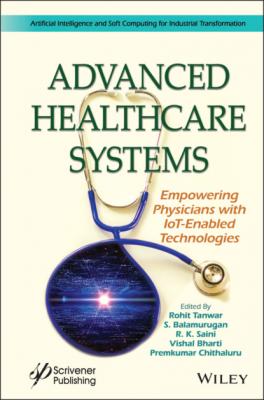Advanced Healthcare Systems. Группа авторов
Чтение книги онлайн.
Читать онлайн книгу Advanced Healthcare Systems - Группа авторов страница 3
 References
References
21 17 IoT-Based Automated Healthcare System 17.1 Introduction 17.2 SDN-Based IoT Framework 17.3 Literature Survey 17.4 Architecture of SDN-IoT for Healthcare System 17.5 Challenges 17.6 Conclusion References
22 Index
List of Illustrations
1 Chapter 2Figure 2.1 Healthcare using IoT.Figure 2.2 Three-layer architecture.
2 Chapter 3Figure 3.1 Analysis of thyroid.Figure 3.2 Categories of thyroid cancer.Figure 3.3 Machine learning life cycle model.Figure 3.4 Analysis of machine learning approach on thyroid.
3 Chapter 4Figure 4.1 Conceptual framework of IoT.Figure 4.2 Barriers of IoT (Source: world economic forum industrial internet sur...
4 Chapter 5Figure 5.1 Flow of step for semi-automated way of segmenting both the lungs in C...Figure 5.2 The positions of S and M.Figure 5.3 (a) Searching in four directions. (b) Region growing based on seed.Figure 5.4 Step for lung segmentation using CT images.
5 Chapter 6Figure 6.1 Typical example of imbalanced data.Figure 6.2 Typical example of balanced data.Figure 6.3 The process of bootstrap aggregation.
6 Chapter 7Figure 7.1 Block diagram of proposed system.Figure 7.2 Arduino 2560 board.Figure 7.3 Voice kit APR 33A3.Figure 7.4 Working circuit diagram of LM35.Figure 7.5 Working of heartbeat sensor.Figure 7.6 Respiration sensor.Figure 7.7 Channels for heath monitoring.Figure 7.8 Flow chart of health monitoring.Figure 7.9 Hardware circuit for hand gesture recognition.Figure 7.10 Gesture and commands accordingly.Figure 7.11 Field chart for body temperature.Figure 7.12 Field chart for heartbeat.Figure 7.13 Field chart for respiration rate.
7 Chapter 8Figure 8.1 Chart showing growth in the usage of IoT devices.Figure 8.2 Areas of IoT devices used.
8 Chapter 9Figure 9.1 Functional block diagram.Figure 9.2 Functional block diagram of power supply.Figure 9.3 Heartbeat sensor.Figure 9.4 Output for heart rate.Figure 9.5 Output for temperature sensor.Figure 9.6 Output for panic button.Figure 9.7 Output for GPS services.
9 Chapter 10Figure 10.1 Overall classification framework.Figure 10.2 Data collection.Figure 10.3 Secured data storage.Figure 10.4 Data retrieval and merging.Figure 10.5 Data aggregation.Figure 10.6 Data partition.Figure 10.7 Training phase.Figure 10.8 Testing phase.Figure 10.9 Collect data from UCI repository dataset.Figure 10.10 Secured data storage.Figure 10.11 Fuzzy temporal neural classification.Figure 10.12 Disease prediction.Figure 10.13 Parameters vs. percentage.Figure 10.14 Methods vs. computational time.
10 Chapter 11Figure 11.1 CloudIoT applications.Figure 11.2 Research methodology.Figure 11.3 IoT layered architecture.Figure 11.4 Interface services.Figure 11.5 Deployment services.Figure 11.6 CloudIoT health architecture.Figure 11.7 Conceptual healthcare scenario.Figure 11.8 CloudIoT security goals.Figure 11.9 List of CloudIoT threats.
11 Chapter 12Figure 12.1 Machine learning steps.Figure 12.2 Difference between algorithmic and machine learning solution.Figure 12.3 Algorithms for machine study types.Figure 12.4 Supervised learning method.Figure 12.5 Classification separates the data; regression fits the data.Figure 12.6 Unsupervised model.Figure 12.7 Unsupervised process.Figure 12.8 Clustering with three clusters.Figure 12.9 General block diagram of NN.Figure 12.10 Internal layers of neural network.Figure 12.11 Block diagram of the EEG classification.Figure 12.12 Decision fusion block diagram.
12 Chapter 13Figure 13.1 Drug development in ML.Figure 13.2 Machine learning in medicinal services.Figure 13.3 ML algorithms for healthcare analytics.Figure 13.4 Team-based consideration effect and ROI.Figure 13.5 Financial impact of clinical quality improvement.
13 Chapter 14Figure 14.1 Training data set is categorized in A or B based on some feature X.Figure 14.2 Showing arrival of new data (green colored dot) for making hypothesi...Figure 14.3 Pre-labeled data of training data set.Figure 14.4 Decision boundary separating data.Figure 14.5 New data D2 is shown with green colored dot.Figure 14.6 The different parts of brain tumor on the basis of T1 and T2 MRIs [1...Figure 14.7 Flowchart representing steps in SWA [19].Figure 14.8 Coarsening of the pixel representation of the portion of MR image.
14 Chapter 15Figure 15.1 Ratio of number of males and females with type 2 diabetes.Figure 15.2 Number of obese and non-obese males and females with type 2 diabetes...Figure 15.3 Ratio of males and females having polyuria and suffering from type 2...Figure 15.4 Ranking of attributes.Figure 15.5 Correlation matrix.Figure 15.6 Covariance matrix.Figure 15.7 Machine learning framework for identification of diabetic.Figure 15.8 Accuracy of deep learning-based neural network without dimensionalit...Figure 15.9 Accuracy of deep learning–based neural network with dimensionality r...
15 Chapter 16Figure 16.1 Dataset of without mask [2].Figure 16.2 Dataset of with mask [2].
16 Chapter 17Figure 17.1 SDN architecture.Figure 17.2 NFV architecture.Figure 17.3 Ring sensor.Figure 17.4 ECG sensor.Figure 17.5 GSR sensor.Figure 17.6 Graphene vapor sensor.Figure 17.7 Health patch sensor.Figure 17.8 Oximeter sensor.Figure 17.9 Optical biosensor.Figure 17.10 Respiration sensor.Figure 17.11 A schematic view of software-defined Internet of Things.Figure 17.12 Overview of different aspects of SDN-based IoT networks.Figure 17.13 Architecture of SDN-IoT for healthcare system.
List of Tables
1 Chapter 2Table 2.1 Security and privacy mechanism prosed in some papers.
2 Chapter 6Table 6.1 Cluster distribution.Table 6.2 Numbers of majority sample in each cluster.
3 Chapter 9Table 9.1 Test case for monitoring the soldiers’ health.
4 Chapter 10Table 10.1 Confusion matrix.
5 Chapter 11Table 11.1 Feature contrast between IoT and conventional networks.Table 11.2 Characteristics of various enabling protocols and technologies.Table 11.3 CloudIoT application areas.Table 11.4 Summary of CloudIoT threats and vulnerabilities.Table 11.5 Overview of proposed security counter measures.Table 11.6 Node energy drainage factors and solutions.
6 Chapter 12Table 12.1 Defined epileptic states in transient EEG signals.Table 12.2 Initially defined epileptic states.
7 Chapter 15Table 15.1 Description of the dataset.Table 15.2 Weights of features with information gain measure.Table 15.3 Performance parameters of deep learning-based model without dimension...Table 15.4 Performance parameters of deep learning-based model with dimensionali...
8 Chapter 16Table 16.1 Classification report using CNN [4].Table 16.2 Classification report using SSDMNV2 [3].Table 16.3 A comparison of various models’ accuracy [3].Table 16.4 A comparison